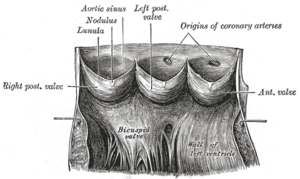Aneurysm of sinus of Valsalva
| Aneurysm of sinus of Valsalva | |
|---|---|
|
Aorta laid open to show the semilunar valves. (Aortic sinus, also known as "sinus of Valsalva", is labeled at upper left.) | |
| Classification and external resources | |
| Specialty | medical genetics |
| ICD-10 |
Q25.4 (EUROCAT Q25.43) |
| ICD-9-CM | 442.9 |
| DiseasesDB | 32260 |
| eMedicine | med/2133 ped/2106 |
Aneurysm of the aortic sinus, also known as the sinus of Valsalva, is comparatively rare. When present, it is usually in either the right (65-85%) or in the noncoronary (10-30%) sinus, rarely in the left (< 5%) sinus.[1]
Causes
This type of aneurysm is typically congenital and may be associated with heart defects. It is sometimes associated with Marfan syndrome or Loeys-Dietz syndrome, but may also result from Ehlers-Danlos syndrome, bicuspid aortic valve,[2] atherosclerosis, syphilis, cystic medial necrosis, chest injury, or infective endocarditis.
Presentation
If unruptured, this type aneurysm may be asymptomatic and therefore go undetected until symptoms appear or medical imaging is performed for other reasons. A ruptured aneurysm typically leads to an aortocardiac shunt and progressively worsening heart failure.[3]
An aneurysm of the aortic sinus may rupture due to infective endocarditis involving the aortic wall and tertiary-stage syphilis.
The manifestations appear depending on the site where the sinus has ruptured. For example, if the sinus ruptures in a low pressure area like the right atrium or right ventricle then a continuous type of murmur is heard. The murmur is located in the left parasternal region mainly confined to the lower sternum. It is also accompanied by a superficial thrill. A ruptured Sinus of Valsalva abscess represents a surgical emergency.
Treatment
Medical therapy of aneurysm of the aortic sinus includes blood pressure control through the use of drugs, such as beta blockers.
Another approach is surgical repair.[4] The determination to perform surgery is usually based upon the diameter of the aortic root (with 5 centimeters being a rule of thumb - a normal size is 2-3 centimeters) and the rate of increase in its size (as determined through repeated echocardiography).
See also
References
- ↑ Topi, Bernard; John Jinu (2012). "An uncommon cause of a continuous murmur" (PDF). Experimental and Clinical Cardiology. 17 (3): 148–149. PMC 3628432
 . PMID 23620707.
. PMID 23620707. - ↑ Weinreich, M; Yu, PJ; Trost, B (2015). "Sinus of valsalva aneurysms: review of the literature and an update on management". Clinical Cardiology. 3 (38): 185–9. doi:10.1002/clc.22359. PMID 25757442.
- ↑ Gray's anatomy, 1902 ed.
- ↑ Vural KM, Sener E, Taşdemir O, Bayazit K (July 2001). "Approach to sinus of Valsalva aneurysms: a review of 53 cases". Eur J Cardiothorac Surg. 20 (1): 71–6. doi:10.1016/S1010-7940(01)00758-8. PMID 11423277.
